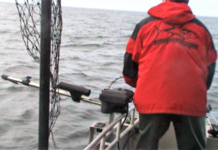
A tsunami-detecting DART buoy, deployed by NOAA Ship Ronald H. Brown in the Pacific ocean, bobs up and down amongst large surface waves.
Looking out at the ocean, one often sees a seemingly infinite series of waves, as far as the eye can see, transporting water from one place to the next. Though waves do cause the surface water to move, the idea that waves are travelling bodies of water is misleading.
Waves are actually energy passing through the water, causing it to move in a circular motion, much like a buoy or seabird floating on the surface. When a wave encounters a surface object, the object appears to lurch forward and upward with the wave, but then falls down and back in an orbital rotation as the wave continues by, ending up in the same position as before the wave came by. If one imagines wave water itself following this same pattern, it is easier to understand ocean waves as simply the outward manifestation of kinetic energy propagating through seawater. In reality, the water in waves doesn’t travel much at all. The only thing waves do transmit across the sea is energy.
The idea of waves being energy movement rather than water movement makes sense in the open ocean, but what about on the coast, where waves are clearly seen crashing down dramatically onto shore? This phenomenon is a result of the wave’s orbital motion being disturbed by the seafloor. As a wave passes through water, not only does the surface water follow an orbital motion, but a column of water below it (down to half of the wave’s wavelength) completes the same movement. The approach of the bottom in shallow areas causes the lower portion of the wave to slow down and compress, forcing the wave’s crest higher in the air. Eventually this imbalance in the wave reaches a breaking point, and the crest comes crashing down as wave energy is dissipated into the surf.
Still, where does a wave’s energy come from? There are a few types of ocean waves and they are generally classified by the energy source that creates them. Most common are surface waves, caused by wind blowing along the air-water interface, creating a disturbance that steadily builds as wind continues to blow and the wave crest rises. Surface waves occur constantly all over the globe, and are the waves you see at the beach under normal conditions.
Adverse weather or natural events often produce larger and potentially hazardous waves. Severe storms moving inland often create a storm surge, a long wave caused by high winds and a continued low pressure area. Storm surges are a minor disturbance in deep water, often less than one meter high, but intensify as they move into shallower water. Submarine earthquakes or landslides can displace a large amount of water very quickly, creating a series of very long waves called tsunamis. Storm surges and tsunamis do not create a typical crashing wave, but rather a massive sea-level rise upon reaching shore and can be extremely destructive to coastal environments as well as human settlements.
For More Information:
Multimedia Discovery Missions: Ocean Waves
Sign up for the Ocean Explorer E-mail Update List.














